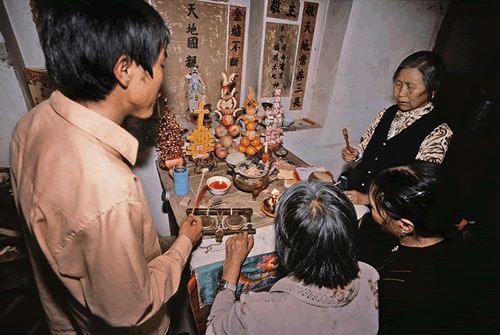What Is Popular Religion?*
WHY “POPULAR RELIGION”?
To define Chinese religion primarily in terms of the three traditions (Confucianism, Daoism, and Buddhism) is to exclude from serious consideration the ideas and practices that do not fit easily under any of the three labels. Such common rituals as offering incense to the ancestors, conducting funerals, exorcising ghosts, and consulting fortunetellers; the belief in the patterned interaction between light and dark forces or in the ruler’s influence on the natural world; the tendency to construe gods as government officials; and the preference for balancing tranquility and movement -- all belong as much to none of the three traditions as they do to one or all three.
UNDERSTANDING THE LIMITATIONS OF THE TERM “POPULAR RELIGION”
Popular religion includes those aspects of religious life that are shared by most people, regardless of their affiliation or lack of affiliation with the three teachings. Such forms of popular religion as those named above (offering incense, conducting funerals, and so on) are important to address, although the category of “popular religion” entails its own set of problems. In fact, it is too broad a category to be of much help to detailed understanding -- which indeed is why many scholars in the field avoid the term, preferring to deal with more discrete and meaningful units like family religion, mortuary ritual, seasonal festivals, divination, curing, and mythology. “Popular religion” in the sense of common religion also hides potentially significant variation. In addition to being static and timeless, the category prejudices the case against seeing popular religion as a conflict-ridden attempt to impose one particular standard on contending groups.
POPULAR RELIGION IN WHAT SENSE?
The term “popular religion” can be used in two senses. The first refers to the forms of religion practiced by almost all Chinese people, regardless of social and economic standing, level of literacy, region, or explicit religious identification. Popular religion in this sense is the religion shared by people in general, across all social boundaries. Three examples, all of which can be dated as early as the first century CE, help us gain some understanding of what counts as popular religion in this first sense: 1) a typical Chinese funeral and memorial service, including the rites related to care of the spirit in the realm of the dead; 2) the New Year’s festival, which marks a passage not just in the life of the individual and the family, but in the yearly cycle of the cosmos; and 3) the ritual of consulting a spirit medium in the home or in a small temple to solve problems such as sickness in the family, nightmares, possession by a ghost or errant spirit, or some other misfortune.
The second sense of “popular religion” refers to the religion of the lower classes as opposed to that of the elite. The bifurcation of society into two tiers is hardly a new idea. It began with some of the earliest Chinese theorists of religion. Xunzi, for instance, discusses the emotional, social, and cosmic benefits of carrying out memorial rites. In his opinion, mortuary ritual allows people to balance sadness and longing and to express grief, and it restores the natural order to the world. Different social classes, writes Xunzi, interpret sacrifices differently: “Among gentlemen [junzi], they are taken as the way of humans; among common people [baixing], they are taken as matters involving ghosts.”(1)
RELIGION AND SOCIAL CLASS
Dividing what is clearly too broad a category (Chinese religion or ritual) into two discrete classes (elite and folk) is not without advantages. It is a helpful pedagogical tool for throwing into question some of the egalitarian presuppositions frequently encountered in introductory courses on religion: that, for instance, everyone’s religious options are or should be the same, or that other people’s religious life can be understood (or tried out) without reference to social status.
Treating Chinese religion as fundamentally affected by social position also helps scholars to focus on differences in styles of religious practice and interpretation. One way to formulate this view is to say that while all inhabitants of a certain community might take part in a religious procession, their style -- both their pattern of practice and their understanding of their actions -- will differ according to social position. Well-educated elites tend to view gods in abstract, impersonal terms and to demonstrate restrained respect, but the uneducated tend to view gods as concrete, personal beings before whom fear is appropriate.
In the social sciences and humanities in general there has been a clear move in the past forty years away from studies of the elite, and scholarship on Chinese religion is beginning to catch up with that trend. More and more studies focus on the religion of the lower classes and on the problems involved in studying the culture of the illiterati in a complex civilization. In all of this, questions of social class (Who participates? Who believes?) and questions of audience (Who writes or performs? For what kind of people?) are paramount.
References
(1) Xunzi jijie, ed. Wang Xianqian, in Zhuzi jicheng (Shanghai: Shijie shuju, 1935), 2:250.
